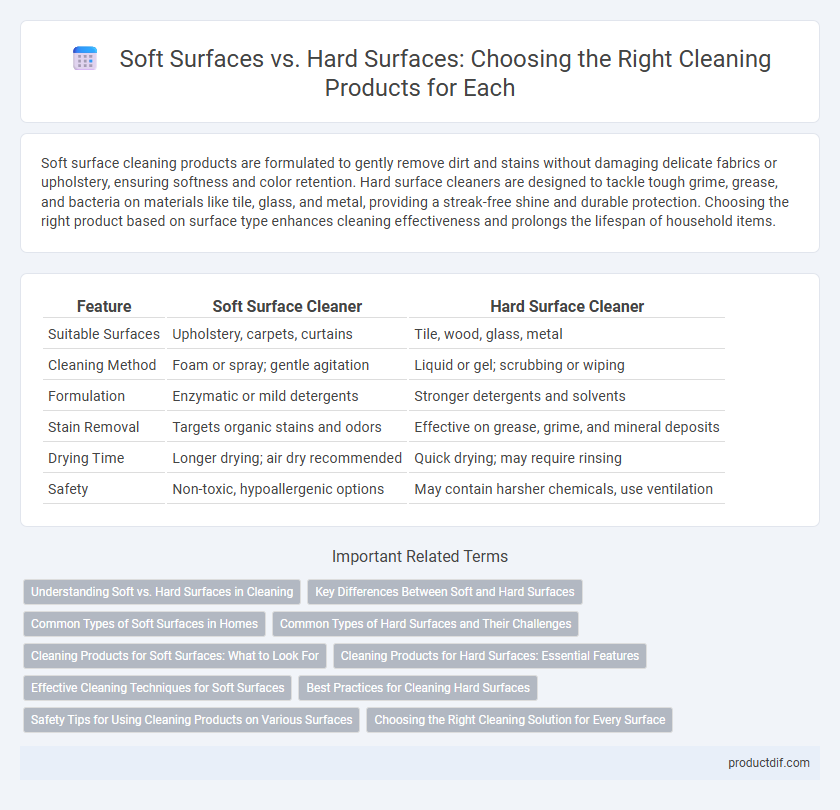Soft surface cleaning products are formulated to gently remove dirt and stains without damaging delicate fabrics or upholstery, ensuring softness and color retention. Hard surface cleaners are designed to tackle tough grime, grease, and bacteria on materials like tile, glass, and metal, providing a streak-free shine and durable protection. Choosing the right product based on surface type enhances cleaning effectiveness and prolongs the lifespan of household items.
Table of Comparison
| Feature | Soft Surface Cleaner | Hard Surface Cleaner |
|---|---|---|
| Suitable Surfaces | Upholstery, carpets, curtains | Tile, wood, glass, metal |
| Cleaning Method | Foam or spray; gentle agitation | Liquid or gel; scrubbing or wiping |
| Formulation | Enzymatic or mild detergents | Stronger detergents and solvents |
| Stain Removal | Targets organic stains and odors | Effective on grease, grime, and mineral deposits |
| Drying Time | Longer drying; air dry recommended | Quick drying; may require rinsing |
| Safety | Non-toxic, hypoallergenic options | May contain harsher chemicals, use ventilation |
Understanding Soft vs. Hard Surfaces in Cleaning
Soft surfaces, such as upholstery, carpets, and curtains, require gentle cleaning products designed to preserve fabric integrity while removing dirt and allergens effectively. Hard surfaces like tiles, countertops, and wood benefit from more robust cleaners that dissolve grease, grime, and stains without damaging the material. Choosing the appropriate cleaning agent based on surface type ensures optimal cleanliness and prolongs the lifespan of both soft and hard surfaces.
Key Differences Between Soft and Hard Surfaces
Soft surfaces like fabrics, carpets, and upholstery require gentle cleaning agents that penetrate fibers without causing damage, while hard surfaces such as tiles, glass, and countertops tolerate stronger disinfectants and abrasive scrubs. Soft surface cleaners often prioritize stain removal and odor neutralization, whereas hard surface products focus on grease cutting, shine enhancement, and bacterial elimination. Understanding these distinctions ensures effective cleaning tailored to the material's texture and durability, extending surface lifespan and maintaining hygiene.
Common Types of Soft Surfaces in Homes
Common types of soft surfaces in homes include carpets, upholstered furniture, curtains, and mattresses. These surfaces require specialized cleaning products designed to gently lift dirt and stains without damaging fibers. Using appropriate cleaners with fabric-safe ingredients helps maintain softness and prolongs the lifespan of soft home furnishings.
Common Types of Hard Surfaces and Their Challenges
Common types of hard surfaces include tile, hardwood, laminate, and stone, each presenting unique cleaning challenges due to varying porosity and finish. Tiles can trap dirt in grout lines, while hardwood requires gentle cleaners to avoid damage and maintain its protective seal. Stone surfaces demand pH-neutral products to prevent etching and preserve their natural texture.
Cleaning Products for Soft Surfaces: What to Look For
Cleaning products for soft surfaces should prioritize gentle, non-abrasive formulas enriched with fabric-safe enzymes and antimicrobial agents to effectively remove stains and odors without damaging fibers. Ingredients like natural plant-based surfactants and hypoallergenic components help maintain the softness and color integrity of upholstery, carpets, and delicate textiles. Opt for products labeled safe for fabrics, free from harsh chemicals such as bleach or ammonia, to ensure long-lasting cleanliness and preservation of soft surface materials.
Cleaning Products for Hard Surfaces: Essential Features
Cleaning products for hard surfaces require formulates that provide effective dirt and grime removal without damaging the material's finish, making durability and non-abrasiveness essential features. Ingredients such as surfactants, solvents, and disinfectants target tough stains and bacteria while maintaining compatibility with materials like tile, glass, metal, and laminate. Fast-drying properties and streak-free results enhance usability, ensuring hard surfaces remain clean and visually pristine after treatment.
Effective Cleaning Techniques for Soft Surfaces
Effective cleaning techniques for soft surfaces prioritize gentle agitation with microfiber cloths or soft-bristle brushes to remove dirt without damaging fibers. Using mild, pH-balanced detergents ensures deep cleaning while preserving the material's texture and color. Steam cleaning is highly effective for sanitizing soft surfaces, breaking down embedded grime and allergens without harsh chemicals.
Best Practices for Cleaning Hard Surfaces
Effective cleaning of hard surfaces relies on using non-abrasive cleaners that remove dirt and bacteria without damaging the finish. Employ microfiber cloths or mops to trap dust and debris efficiently, while disinfecting agents with proven efficacy against pathogens ensure thorough sanitation. Regular maintenance and immediate spill cleanup prevent buildup, preserving surface integrity and extending the lifespan of hard flooring and countertops.
Safety Tips for Using Cleaning Products on Various Surfaces
When using cleaning products on soft surfaces like upholstery or carpets, always test a small hidden area first to check for discoloration or damage and use products specifically designed for fabric safety. For hard surfaces such as countertops, tile, or hardwood floors, ensure the cleaner is non-abrasive and suitable for the material to prevent scratches or chemical degradation. Wearing gloves and ensuring adequate ventilation minimizes exposure to fumes and protects skin regardless of the surface type.
Choosing the Right Cleaning Solution for Every Surface
Selecting the appropriate cleaning product depends on the surface type, with soft surfaces like upholstery and carpets requiring gentle, pH-balanced formulas to avoid damage while effectively removing stains and odors. Hard surfaces such as tile, glass, and hardwood benefit from stronger, residue-free cleaners designed to dissolve grime and disinfect without causing scratches or discoloration. Understanding the material composition and cleaning needs ensures optimal maintenance and prolongs the lifespan of both soft and hard surfaces.
Soft surface vs Hard surface Infographic

 productdif.com
productdif.com